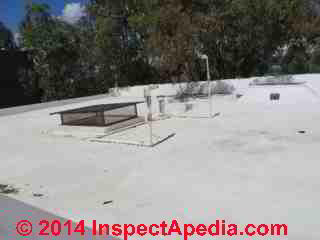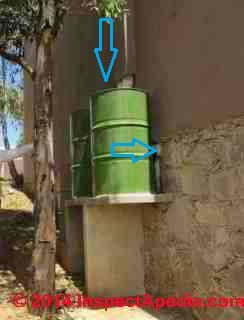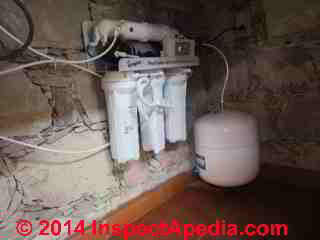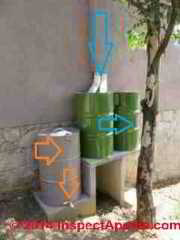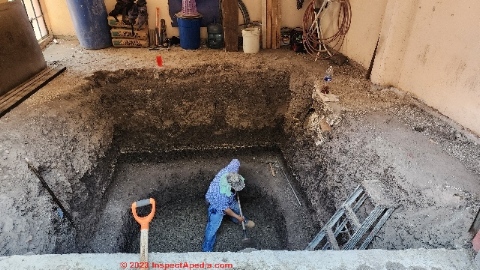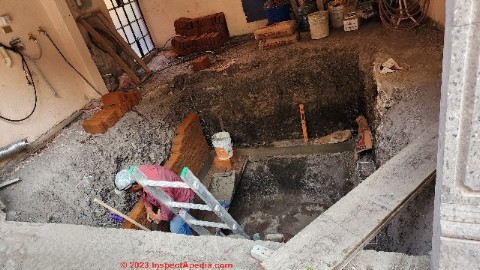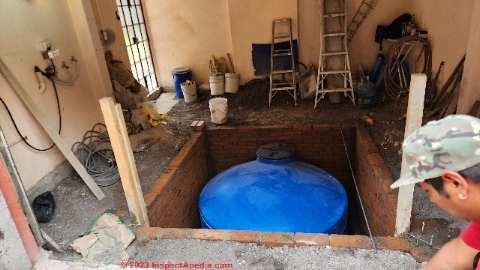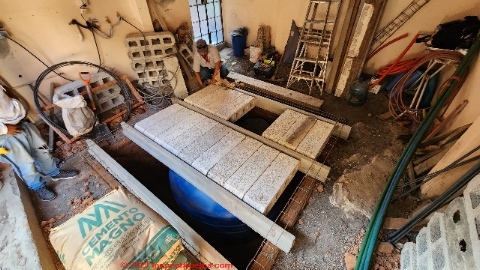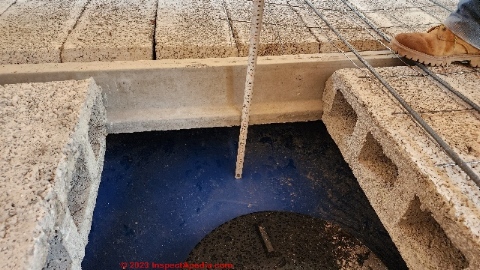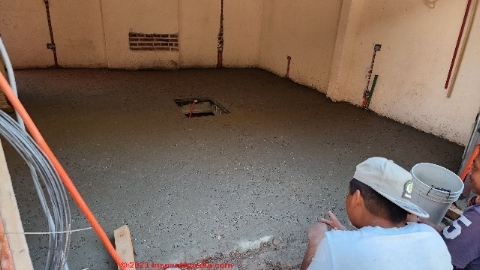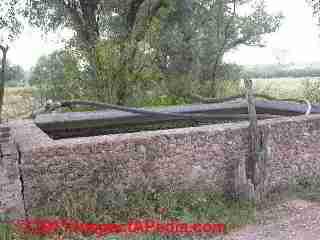 Rainwater Collection & Storage
Rainwater Collection & Storage
Cistern Construction
Design recommendations for building a traditional rainwater storage cistern
- POST a QUESTION or COMMENT about building a water cistern, rainwater storage, cistern construction & cistern sanitation
Cistern construction recommendations: this article describes the construction requirements for a site-built water storage system and includes details for diverting rooftop rainwater drainage into the cistern fdor water storage. We also describe a simple graywater re-use system installed at the same building site.
InspectAPedia tolerates no conflicts of interest. We have no relationship with advertisers, products, or services discussed at this website.
- Daniel Friedman, Publisher/Editor/Author - See WHO ARE WE?
Design Details for a Traditional Rainwater Collection, Storage Cistern, & Graywater Re-Use Systems
In a sequence of photographs here we describe a rooftop rainwater collection system that sends clean roof runoff into a very large masonry cistern built below a home in Guanajuato, Mexico. The building owners and system designers LM and DP live atop a mountain where water is scarce and expensive to have delivered.
Above we see a large low slope rooftop area that collects rainwater during the rainy season. Skylights, a rooftop access hatch, and a solar water heating system are also installed on this roof.
A masonry border or low parapet wall around the rooftop is penetrated at several drain locations to direct rainwater into pipes that in turn carry water to the basement cistern.
Screening (above) keeps eucaluptus leaves and other rooftop debris out of the piping. At initial rainfall water can be diverted away from the cistern so that water containing dust and bird droppings can be flushed from the roof and system before subsequent rainfall is diverted into the cistern itself.
Roof drainage is piped to a steel drum whose interior was cleaned and painted and filled with large rocks to absorb the shock of a heavy water flow into the system (below left).
The catch-drum outlet then directs water through the building's wall and into the rainwater storage cistern. The designers placed the drum outlet above its bottom to permit settlement of dust and debris that can be periodically removed.
A pump located in the cistern delivers water up to the building's various plumbing fixtures. At point of use in the kitchen where safe water potability must be assured, the owners installed a water purification system including a reverse osmosis treatment anda cascade of water filters (below).
This thoughtful rainwater catchment system in active use in a dry climate includes several interesting design features including the ability to have rain provide a rooftop dust flush before rainwater is diverted into the cistern and an extensive grayater collection system (orange arrows shown on the gray barrell at below left) that in parallel to the cistern conserves graywater for application to gardens and trees on the site.
A simple ball valve connected to the graywater container permits connection of a hose to direct graywater to where it is to be applied on nearby garden or trees.
More about graywater re-use systems is at GREYWATER SYSTEMS
For another very simple rainwater collection system see the rainwater collection and storage tank we show in our article
at PASSIVE SOLAR HOME, LOW COST)
also designed for collecting as much rainwater as possible when rainy weather occurs.
Reader Question: advice on building a traditional cistern
6/24/2014 Robert said:
I have questions regarding very much older durable cisterns. First, my Grandfather's was partially below and partially above ground and it was round, maybe 8 ft across diameter. It collected water off his galvanized tin roof and gutters that passed through some very fine screens into the cistern.
I seem to recall that the liner for lack of a better word was use of something like the white very flat rectangular brick sort of like Fire Brick and probably concrete mortar but that is as much as I can recall. It was used for drinking water and just about everything. He just used a small galvanized bucket to drop and pull up the water.
The question is are there old designs of this type to be found somewhere. All I know is it worked fine and I loved the water out of it. This did not hit the ground so there was no, at that time, concern for harmful bacteria.
I suspect our air was much cleaner then too. Anyway, I really want to try to find out how his may have likely been built because I would like to try building one primarily for drinking use or cooking. I also plan to have no trees near the house so no big problem with leaves.
I do not recall any trees anywhere in the vicinity of his gutters or the cistern; they were all away from the house.
Can you help me with some information?
Robert <raptor.1.robert@gmail.com>
Reply: Cistern Specifications & Design Tips
Robert,
As we corresponded by email, cisterns are still used all over the world for water storage; in addition to keeping out debris, you may need to test (or sanitize) the water before using it for drinking.
Cisterns tend to be site-built of masonry, often open-topped or concrete-topped and may be above-ground or below ground.
 Since traditional cistern construction is basically a masonry box lined with high-portland cement to improve its water tight properties, we don't find many plans or design specifications. But I can list a few features you'll want to consider besides building the cistern box itself:
Since traditional cistern construction is basically a masonry box lined with high-portland cement to improve its water tight properties, we don't find many plans or design specifications. But I can list a few features you'll want to consider besides building the cistern box itself:
Photo at left: water delivery to a stone cistern located in the floor of a restaurant in San Miguel de Allende, Guanajuato, Mexico.
- Cistern wall & bottom construction:
walls need to be strong enough to withstand weather, earth pressure (if below ground), and thermal movement (if in a freezing climate where you'd need to protect from frost push). - Cistern top construction:
must be strong enough to be perfectly safe against collapse or against someone falling in. A cistern constructed below a driveway, for example would need to be able to withstand heavy vehicle loading as well as earth cover loading and would also be at risk of contamination if a vehicle leaks oil or fuel in the area. - Cistern location:
locating a cistern where it can be filled by rainwater can be a critical consideration in dry climates where rainwater storage is essential.
Even where rainwater is not to be used to fill a cistern, if you are going to add water by delivery from a truck consider the requirement for convenient vehicle access. Traditional construction of cisterns in building basements is not my preferred design in new construction in northern climates if the cistern is going to contribute un-wanted indoor moisture to the structure. - Cistern water entry, water outlets, and drainage:
we may need to include four water connections, depending on cistern design and location:- One or more water inlets
to supply the cistern from a water source. Our friends David and Linn in Guanajuato cleverly designed their home's roof to collect rainwater and to direct it into a large cistern. The initial roof drainage is directed out of the cistern until dust accumulated on the roof has been washed away, then subsequent roof runoff is aimed into the cistern. - Cistern water supply to the point of use:
may be by gravity for uphill or rooftop cisterns, or may require a pump system.
See PUMP, WATER PRESSURE BOOSTING for a type of pump and tank suitable for supplying water from a cistern. - Cistern overflow: provide
for directing excess water to a safe location that won't damage the building if cistern input (say from rainwater) has filled the cistern to capacity. - Cistern drainage:
for the purposes of cleaning or repair it may be necessary to empty the cistern.
- One or more water inlets
- Cistern inspection, entry, repair:
most cisterns of large capacity include an access opening for inspection or repair.
I extend the "cistern" concept to include large plastic water tanks that are usually located above ground and sometimes on building roofs.
To consider the plastic tank alternative, see ROOFTOP WATER TANKS
More about using plastic tanks for water storage incuding possible health concerns associated with storing water in some types of plastic is
at PLASTIC RECYCLING CODES, TANKS, TYPES
In-Ground Cistern Installation in San Miguel de Allende
These photographs illustrate the excavation and construction of a vault into which a large (over 1300L) plastic cistern was installed in San Miguel de Allende in Guananjuato, Mexico in 2023.
This cistern will initially store water supplied by the city's municipal water supply system but may ultimately be modified to also accept and use harvested rainwater from the building's rooftop.
Below: the worker excavates a vault below what had been the floor of a small garage. The garage slab was broken up and removed, and the excavation was entirely by hand.
[Click to enlarge any image]
Workers commented that as the vault pit got quite deep, temperatures were actually hot in the pit.
Below: the worker is installing a simple single wythe brick wall to form the surround fodr the future tank fault.
Below: the enormous plastic water storage tank has been installed with its black cover facing the building's interior wall. You can see the finished brick vault walls whose purpose is simplhy to hold back soils away from the tank.
The contractor said they would install a sump pump in the front left corner of the tank vault so that in the now less-likely event of a tank leak or flooding groundwaters entering the tank vault, the water can be removed.
Below: the contractor uses steel-reinforced beams and concrete blocks to form the cover over the cistern vault. To fit the exact and non-standard sistance between the last pair of beams the contractor uses a concrete saw to custom-cut concrete blocks to fit.
Photo below: the architect is measuring the vertical distance between the floor surfaces and the top of the cistern. The concrete floor itself has not been installed bu tyou can see some of the steel reinforcing re-bar as well as rectangular wire mesh that will be used in the floor system.
And in our last photo, below, the garage floor concrete slab has been completed. You can see the rectangular access hatch in the floor as the remaining point of access to the cistern top and cover.
Exiting from that same point, and not yet installed, will be both electrical wiring for the pump used to deliver water from the storage tank and of course water piping connections in and out of the tank.
Cistern Construction & Rainwater Harvesting Research
-
Ali, A., T. Oweis, A. B. Salkini, and S. El-Naggar. "Rainwater cisterns: traditional technologies for dry areas." ICARDA, Aleppo, Syria. iv (2009).
- Artiola, Janick F., Channah Rock, and Gary Fix. WATER STORAGE TANK DISINFECTION, TESTING, AND MAINTENANCE [PDF] (2012). College of Agriculture and Life Sciences, University of Arizona (Tucson, AZ) retrieved 2021/02/03 original source: https://repository.arizona.edu/bitstream/handle/10150/255333/az1586-2012.pdf?sequence=1
- Edwards, D., and K. Keller. 1984. A Workshop Design for Rainwater Roof Catchment Systems (Training Guide) and Appendix: Rainwater Harvesting for Domestic Water Supplies in Developing Countries. La Paz, UNESCO/ROSTLAC, UNICEF, Instituto de Hidráulica e Hidrología.
- Eisner, Neil. METHOD FOR INHIBITING ALGAE GROWTH IN WATER TANKS AND APPARATUS THEREFOR [PDF] U.S. Patent 7,118,700, issued October 10, 2006.
- Gnadlinger, Johann. "Technical presentation of various types of cistern built in the rural communities of the semi-arid region of Brazil." In 9th IRCSA Conf. 1999.
- Gnadlinger, Joao. "Lime—the great sealer: constructing low-cost, sub-surface rainwater tanks in Brazil." Waterlines 14, no. 2 (1995): 11-14.
- Gould, J.E. 1990. "Development of Rainwater Catchment Systems: Technology and Implementation Strategies in the 1980's and Lessons for the 1990's." In: Experiences in the Development of Small-Scale Water Resources in Rural Areas: Proceedings of the International Symposium on Development of Small-Scale Water Resources in Rural Areas, Bangkok, Carl Duisberg Gesellsehaft, South East Asia Program Office, pp. 95-105.
- Gould, John E. "The Fourth International Rainwater Cistern Systems Conference." Waterlines 8, no. 2 (1989): 31-31.
- Gould, John E. "The Rain-water Cistern Systems Conference in Thailand." Waterlines 6, no. 2 (1987): 12-13.
- Hadwen, P. 1987. "Caribbean Islands: A Review of Roof and Purpose Built Catchments." In Non-Conventional Water Resources Use in Developing Countries. New York, United Nations, pp. 455-468. (Natural Resources/Water Series No. 22).
- Haebler, R.H., and D.H. Waller. 1987. "Water Quality of Rain Water Collection Systems in the Eastern Caribbean." In Proceedings of the Third International Conference on Rainwater Cistern Systems. Khon Kaen, Thailand, Khon Kaen University.
- Hallahan, Dennis, Larry Earney, HIGH PERFORMANCE TANKS YIELD MORE EFFICIENT DELIVERY AND INSTALLATION [PDF] Infiltrator Water Technologies, [cited below], Email: info@infiltratorwater.com Tel: 800-221-4436 Website: infiltratorwater.com retrieved 2019/04/22 original source: https://www.infiltratorwater.com/white-papers/high-performance-tanks-yield-more-efficient-delivery-and-installation/
Excerpt:
Installers face site and regulatory challenges that dictate tank selection including the need to design compact systems for small lots or systems in environmentally sensitive areas. Advanced wastewater treatment for limited or sensitive sites and rainwater harvesting for potable and non-potable water are two major areas demanding a new approach to tank construction and use. The need for large tanks that can be easily transported to often remote sites is another catalyst spurring the move to lightweight and durable plastic tanks. - Hasse, Rolf, Rainwater Reservoirs Above Ground Structures for Roof Catchment: Most Common Rainwater Tanks in Comparison and Construction Manual,
may be helpful to people constructing rainwater collection and reservoir systems for use in arid climates such as Mexico and the U.S. Southwest. - Heggen, RJ. 1984. "Rainwater Catchment Systems: A Review." In Proceedings of the Second International Conference on Rainwater Cistern Systems (H.H. Smithe, ed.). St. Thomas, U.S.V.I., Caribbean Research Institute and Virgin Islands Branch, ASCE, pp. A3.1-A1-13.
- HU, Wen-wu, Ping JIANG, Wei-zhong AI, and Song-ling SUN. "Research on wireless farming cistern control system based on self-study mechanism [J]." Electronic Design Engineering 4 (2010): 003.
- Ikebuchi, Shuichi, and Seiji Furukawa. "Feasibility Analysis of Rain Water Cistern Systems as an Urban Water Supply Source." In Proc. Rain Water Cistern Systems Conf, pp. 118-127. 1982.
- Irwin, Ross W., and Ross W. Irwin. "Cistern for domestic water use." Canadian agricultural engineering 19, no. 1 (1977): 12.
- Isquith, Irwin R., and Harvey Winters. "The microbial analysis of domestic cistern water in the US Virgin Islands." Desalination 66 (1987): 415-421.
- Isquith, Irwin R., Harvey Winters, and Agreement No. Microbial Analysis of Domestic Cistern Water in the US Virgin Islands. Water Resources Research Center, College of the Virgin Islands, 1981.
- Jian, Tu. "A Brief Talk On Cistern Design." Forestry Science and Technology Information 3 (2007): 045.
- Junker, M. 1995. Abastecimiento de Agua Potable en los Asentamientos Indígenas de Diez Leguas. Filadelfia, Paraguay. Dirección de Recursos Hídricos de Paraguay e Instituto Federal de Geociencias y Recursos Naturales de Alemania. (Cooperación Hidrogeológica Paraguayo-Alemana, Informe Técnico N°1)
- Kinkade-Levario, Heather, Design for Water: Rainwater Harvesting, Stormwater Catchment, and Alternate Water Reuse, .
Outlines the process of water collection from multiple sources-landscape, residential, commercial, industrial, school, park, and municipal systems Provides numerous case studies, Details the assembly and actual application of equipment, Includes specific details, schematics, and references.
All aspects of rainwater harvesting are outlined, including passive and active system setup, storage, storm water reuse, distribution, purification, analysis, and filtration. There is even a section on rainwater harvesting for wildlife.
In addition to rainwater, there are several affordable and accessible alternate sources, including cooling tower bleed-off water, air conditioning condensate, gray water, and fog collection. Design for Water is geared to providing those making development decisions and guidelines with the information they need to set up passive harvesting techniques.
- Krämer, S. "Improving the Construction of Cisterns in Yemen and the Cistern Water Quality." Fachhochsschule Giessen Friedberg, University of Applied Sciences (2003).
- König, Klaus W., and Dietmar Sperfeld. "Rainwater harvesting—A global issue matures." Sustain. Water Manag 1 (2007): 31-35.
- Lorenzo, Nieves. 1988. Proyecto de Presupuesto para la Construcción de Cisternas Rurales en los Caseríos Corozalito y el Guanábano del Distrito Zamora Estado Flacón. Coro, Venezuela, FUDECO-PIDZAR.
- Lye, Dennis J. "Microbiology of rainwater cistern systems: A review: (Cistern, Rainwater, Microorganisms)." Journal of Environmental Science & Health Part A 27, no. 8 (1992): 2123-2166.
- Macomber, Patricia S.H., Guidelines on rainwater catchment systems for Hawaii, CTAHR resource management
This more technical document may be especially helpful for rainwater collection and recycling systems for climates where there is heavy rainfall such as demonstrated for Hawaii.
- McGeever, B., and T. H. Thomas. Underground storage of rainwater for domestic use; including construction details of a low-cost cistern and pumps. Working Paper 49, DTU, Warwick University, UK, 1997.
- Memarian, Gholam Hossein. "introducing Some Aspects Of Iranian Vernacular Architecture: Construction Of Abanbar Or Underground Cistern." Journal of Architecture and Urban Planning (2009).
- OAS, RAINWATER HARVESTING FROM ROOFTOP CATCHMENTS [PDF] OAS, Organization of American States 17th Street and Constitution Ave., NW Washington, D.C., 20006-4499 USA, Tel: 1 (202) 370 5000, retrieved 2016/06/29, original source: http://www.oas.org/dsd/publications/unit/oea59e/ch10.htm
- Nissen-Petersen, Erik & John Gould, Rainwater Catchment Systems for Domestic Supply: Design, Construction and Implementation,
... the art of roof and ground catchment systems for rainwater. The water collected can be used for household or other purposes. The designs are aimed for individuals with limited access to electricity and/or civic water utilities. The text includes drawings, photographs and step-by-step instructions.
- Olem, Harvey, and Paul M. Berthouex. "Acidic deposition and cistern drinking water supplies." Environmental science & technology 23, no. 3 (1989): 333-340.
- Patel, I. Pravin, and II Rajesh Dhore. USE OF GEOSYNTHETICS IN WATER HARVESTING [PDF] Proc. of The Third Intl. Conf. on Advances in Civil, Structural and Environmental Engineering - ACSEE 2015
ISBN: 978-1-63248-065-1 doi: 10.15224/ 978-1-63248-065-1-89
Keywords— Geosynthetics, rainwater, water harvesting, recharging, stram water drain, water logging, recharge-pit. - Petersen, Andrew. "The archaeology of the Syrian and Iraqi Hajj routes." World Archaeology 26, no. 1 (1994): 47-56.
- Shao-bing, L. I. U. "Design and Construction of Cistern Roofing [J]." Journal of Hunan Urban Constructin College 4 (2000): 009.
- Silva, A. de Souza, and E. Rocha Porto. 1982. Utilização e Conservação dos Recursos Hídricos en Areas Rurais do Trópico Semi-árido do Brasil. Petrolina, PE, Brazil, EMBRAPA-CPATSA. (Documento No. 14)
- -----, et al. 1984. Cisternas Rurais. Dimensionamento, Construção e Manejo. Petrolina, PE, Brazil, EMBRAPA-CPATSA-SUDENE. (Circular Técnica No. 12)
- -----, et al. 1988 Captação e Conservação de Água de Chuva no Semi-árido Brasileiro: Cisternas Rurais. II. Agua para Consume Humano. Petrolina, PE, Brazil, EMBRAPA-CPATSA. (Circular Técnica No. 16)
- Smith, Henry H. 1983. Effects of Various Factors on the Sizing of Rain Water Cistern Systems. #2 John Brewers Bay, St Thomas, College of the Virgin Islands, Caribbean Research Institute. (Technical Report No. 19)
- Solomon, Hossana, and Henry H. Smith. "Effectiveness of Mandatory Law of Cistern Construction for Rainwater Harvesting on Supply and Demand of Public Water in US Virgin Islands." In Seventh Caribbean Islands Water Resources Congress, p. 75. 2007.
- Still, Gwilym T. Y Terry Thomas, THE OPTIMUM SIZING OF GUTTERS FOR DOMESTIC ROOFWATER HARVESTING [PDF] (2002) DTU, Domestic roofwater Harvesting Research Programme, School of Engineering, University of Warwick, retrieved 2023/05/04, original source: rainharvest.com/more/Optimize-Gutter-Rain-Retrieval.pdf
Abstract excerpt:
Guttering, in a roofwater harvesting system, has the purpose of intercepting the roof run-off and conveying it to a downpipe (which in turn carries it to a store). The two phases of ‘interception’ and ‘conveyance’ make different and sometimes conflicting demands upon a guttering design.
Their respective failures (overshoot and overflow) occur under similar circumstances, namely intense rain, and for most analytic purposes it is appropriate to consider as total water loss just the higher of the overshoot loss and the overflow loss, rather than their sum. A
good gutter design must satisfy many criteria including durability, cheapness and ease of fixing. In this paper on gutter sizing, the primary approach is to find that gutter size and shape that maximises the ratio of water benefit to system cost. - Thomas, T. H., and B. McGeever. "Underground Storage of Rainwatewr for Domestic Use (Including Construction Details of a Low-Cost Cistern and Pumps)." (1997).
- United Nations. Department of Technical Cooperation and Development. 1989. Roof Catchments, Roof Coverings, Guttering and Downpipes. New York. (United Nations Water Resources Assessment and Planning in Pacific Islands; UNDP Project RAS/87/009)
- Vincent, Linden. The politics of water scarcity: irrigation and water supply in the mountains of the Yemen Republic. Overseas Development Institute, 1990.
- Wahlin, L. "The family cistern: 3,000 years of household water collection in Jordan." In Ethnic Encounter and Culture Change. Papers from the Third Nordic Conference on Middle Eastern Studies, Joensuu, Finland, pp. 19-22. 1995.
- Waller, D.H. 1982. "Rainwater as a Water Supply Source in Bermuda." In Proceedings of the First International Conference on Rain Water Cistern Systems. Honolulu, University of Hawaii, Water Resources Research Center, pp. 184-193.
- Xiaozu, Yartg Zhijie Su. "Calculation of Rectangular Cistern on Winkler Elastic Foundation [J]." Special Structures 2 (2006): 011.
- Yi, Li. "A Talk On The Design of The Control of Water Level in Underground Cistern." Fujian Architecture & Construction 3 (2002): 038.
- Young, Edward S., and William E. Sharpe. "Atmospheric deposition and roof-catchment cistern water quality." Journal of environmental quality 13, no. 1 (1984): 38-43.
- Zhu,K, and L. Zhang, W. Hart, M. Liu, H. Chen, Quality issues in harvested rainwater in arid and semi-arid Loess Plateau of northern China,
(out of print, find by search and deferred order).
Amazon's description may be helpful:
Loess soils cover vast areas in the arid and semi-arid regions of northern China. Due to the lack of reliable surface water and ground-water, rainwater harvesting has played a prominent role in farmers' domestic usage and agricultural irrigation. An economical and valid type of water storage cistern with optimum design of components has been introduced to rural areas in the Loess Plateau.
Different collection alternatives showed apparent variations in rainwater quality. by using different catchments, such as mortar roofs and cement-paved courtyards, compacted land or road surfaces, rainwater can be effectively collected for storage in cisterns. This study focused mainly on the quality of rainwater harvested from the different catchment systems and stored for different periods of time.
By analysis of the water samples stored in these cisterns, it was evident that rainwater quality could be improved significantly by self-purification during the storage.
With emphasis on rainwater quality affected by the different catchment systems, it was found that the measured inorganic compounds in the rainwater harvested from roof-yard catchment systems generally matched the WHO standards for drinking water, while the concentrations of some inorganic compounds in the rainwater collected from land and road surfaces appeared to be higher than the guideline values for drinking water, but generally not beyond the maximum permissible concentrations.
However, Fecal Coliform, which is an important bacteriological parameter for the three catchment systems, exceeded the limits of drinking water to a greater extend. Trace amounts of 55 organic pollutants were identified, including aliphatic hydrocarbons, aromatic compounds and phthalate esters, etc.
The analytical results indicated that roof-yard catchments that included the ''first flush'' usually provided safe drinking water with low organic contents, even for rainwater collected immediately after rainfall. In contrast, rainwater harvested from road surfaces had poor quality with respect to the organic constituents, regardless of stored time.
...
Continue reading at CISTERNS, WATER STORAGE - topic home, or at or select a topic from the closely-related articles below, or see the complete ARTICLE INDEX.
Or see these
Recommended Articles
- CAULKS, NONTOXIC - may aid in repairing leaks in some types of water storage cisterns
- CISTERNS, WATER STORAGE - home
- ATTIC CISTERNS
- BASEMENT CISTERNS
- CISTERN & RAINWATER COLLECTION SYSTEMS
- CISTERN USE ADVICE
- GRAVITY FEED TANKS
- FREESTANDING WATER TANKS
- LARGE CAPACITY WATER STORAGE TANKS
- ODORS IN WATER
- PLASTIC RECYCLING CODES, TANKS, TYPES
- RAINWATER STORAGE CISTERNS
- HUD FINANCE & CISTERNS
- ROOFTOP WATER TANKS
- WATER TANK CLEANING CODES STANDARDS
- WATER TANK DRAIN VALVE
- WATER TANK LOCATION GUIDE
- WATER TANK SIZE & VOLUME
- WATER TOWERS
- GEOTEXTILES & DRAINAGE MATS - properties, sources, uses in rainwater harvesting
- PASSIVE SOLAR HOME, LOW COST - collects rainwater into a large cistern
- VARIABLE FREQUENCY / VARIABLE SPEED DRIVE WELL PUMPS (VFDs) - useful in some rainwater harvesting & cistern systems
- WATER SOURCE ALTERNATIVES
- WELL CLEARANCE DISTANCES - water source clearances from potential pollutant sources, & possible exceptions that can permit use of cisterns for drinking water supply.
Suggested citation for this web page
CISTERN & RAINWATER COLLECTION SYSTEMS at InspectApedia.com - online encyclopedia of building & environmental inspection, testing, diagnosis, repair, & problem prevention advice.
Or see this
INDEX to RELATED ARTICLES: ARTICLE INDEX to WATER SUPPLY, PUMPS TANKS WELLS & SPRINGS
Or use the SEARCH BOX found below to Ask a Question or Search InspectApedia
Ask a Question or Search InspectApedia
Try the search box just below, or if you prefer, post a question or comment in the Comments box below and we will respond promptly.
Search the InspectApedia website
Note: appearance of your Comment below may be delayed: if your comment contains an image, photograph, web link, or text that looks to the software as if it might be a web link, your posting will appear after it has been approved by a moderator. Apologies for the delay.
Only one image can be added per comment but you can post as many comments, and therefore images, as you like.
You will not receive a notification when a response to your question has been posted.
Please bookmark this page to make it easy for you to check back for our response.
IF above you see "Comment Form is loading comments..." then COMMENT BOX - countable.ca / bawkbox.com IS NOT WORKING.
In any case you are welcome to send an email directly to us at InspectApedia.com at editor@inspectApedia.com
We'll reply to you directly. Please help us help you by noting, in your email, the URL of the InspectApedia page where you wanted to comment.
Citations & References
In addition to any citations in the article above, a full list is available on request.
- In addition to citations & references found in this article, see the research citations given at the end of the related articles found at our suggested
CONTINUE READING or RECOMMENDED ARTICLES.
- Carson, Dunlop & Associates Ltd., 120 Carlton Street Suite 407, Toronto ON M5A 4K2. Tel: (416) 964-9415 1-800-268-7070 Email: info@carsondunlop.com. Alan Carson is a past president of ASHI, the American Society of Home Inspectors.
Thanks to Alan Carson and Bob Dunlop, for permission for InspectAPedia to use text excerpts from The HOME REFERENCE BOOK - the Encyclopedia of Homes and to use illustrations from The ILLUSTRATED HOME .
Carson Dunlop Associates provides extensive home inspection education and report writing material. In gratitude we provide links to tsome Carson Dunlop Associates products and services.


